
GINZA CONNECTIVE
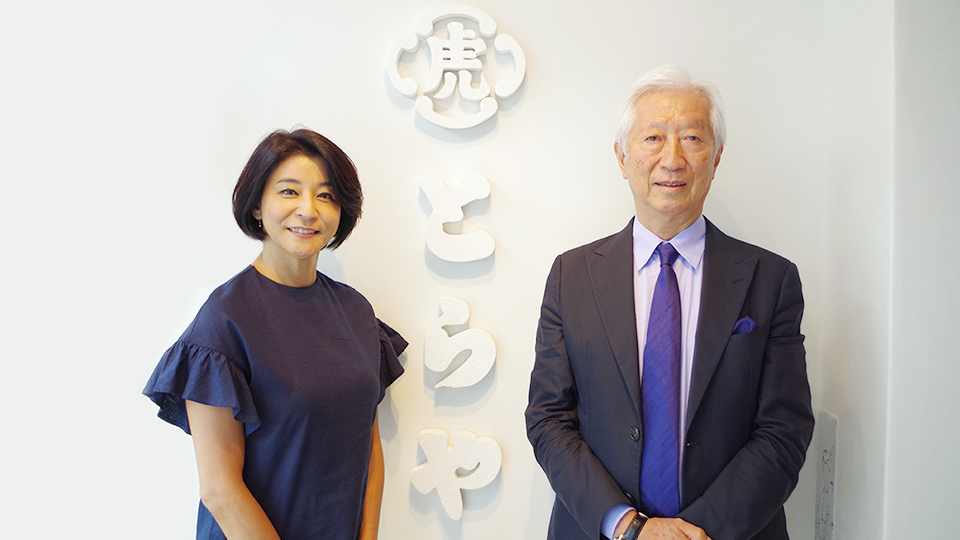
GINZA CONNECTIVE VOL.72
Mitsuhiro Kurokawa× Chisako Takashima
2017.11.01
An interview series featuring Ginza people in conversation with violinist Chisako Takashima. With a special fondness for Ginza, which holds many memories both from her professional and private lives, Takashima explores Ginza from various dimensions with her guests.In this volume, she welcomes Mr. Mitsuhiro Kurokawa, the 17th storeowner and President & CEO of Toraya, a Japanese confectionery store established in the late Muromachi period.
The five-century history of Toraya, Japan’s prestigious long-established confectionery store
- Takashima
- Toraya is said to have been established in the Muromachi (1338-1573) period. Have you always been a wagashi (Japanese confectionery) store?
- Kurokawa
- Yes, we have. We are not sure of the exact year of establishment, but we started our business in Kyoto in the 16th century and we have made wagashi since then.
- Takashima
- That means you have been in business for almost…
- Kurokawa
- Almost 500 years.
- Takashima
- That is amazing! When did you come to Tokyo?
- Kurokawa
- When the capital was moved from Kyoto to Tokyo in Meiji 2 (1869), we established a new store in Tokyo as a Royal Warrant holder, keeping our store in Kyoto. In Meiji 12 (1879), we opened the store in Akasaka. Our store in Ginza was only opened after World War II.
- Takashima
- What is Toraya’s oldest wagashi to your knowledge?
- Kurokawa
- The oldest order received from the Imperial family on record (according to a copy of order) dates back to 1635. By 1695, a catalogue of our line of confectioneries had been produced. According to records, the “Tokonatsu,” the confectionery made from kudzu (arrowroot starch) that you are eating now, was made as a higashi (dry confectionery) in 1711.
- Takashima
- Really!? I understand that you need sugar to make wagashi, and I would presume that it was a luxury back in those times.
- Kurokawa
- Yes. Sugar is said to have been brought to Japan from China by Ganjin–wajo during the Nara (710-794) period, when it was very valuable and used for medical purposes rather than as a sweetener. A more common sweetener was the five-leaf ginseng, which also appears in Makura-no-soshi by Seisho Nagon. However, since all sweeteners were rare at the time, this wagashi may not have been made as sweet as it is today, even if it was shaped the same.
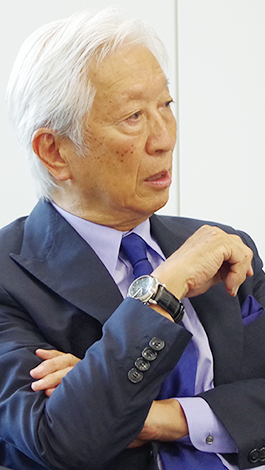
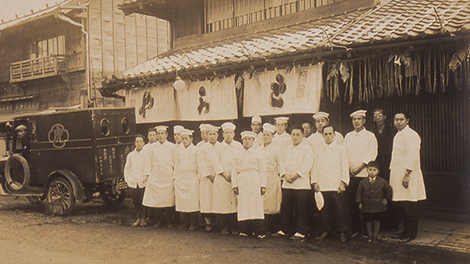
Akasaka store on New Year’s Day in Taisho 14 (1924)
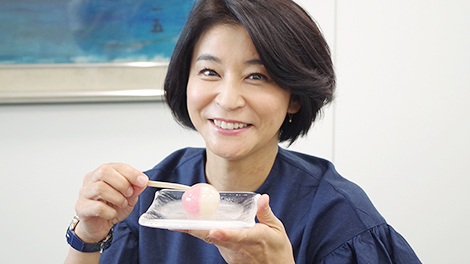
The charm of wagashi lies in its representation of changing seasons
- Takashima
- Could you please define wagashi?
- Kurokawa
- My definition of wagashi is confectionery made from plant-based ingredients. For example, this confectionery is made from kudzu (arrowroot starch) and azuki red beans. Although some baked confectioneries use eggs, wagashi basically does not include animal ingredients.
- Takashima
- I see! That is indeed true. Are there any other characteristics that are unique to wagashi?
- Kurokawa
- Another important feature of wagashi is that it depicts each season. At this time of year (early July at time of interview), kudzu (arrowroot starch) gives confectioneries a refreshing appearance and texture. The name “Tokonatsu (perpetual summer)” also matches the season.
- Takashima
- Come to think of it, the names of many wagashi sound like they were derived from literature.
- Kurokawa
- My wish is for wagashi to be enjoyed using all five senses – the sense of taste, sight, smell, touch, and also hearing. In that aspect, the name of wagashi is an important factor. The impression of a name can change the impression of the taste. This sensation was also shared by our ancestors, who named confectioneries after lines from Genji Monogatari (The Story of Genji) and Kokin Wakashu. A lot of thought was put into the name of wagashi.
- Takashima
- Have you encountered any inspiring names recently?
- Kurokawa
- Yes, the “Yururuka.” This old Japanese word appears in Genji Monogatari and means “gentle” or “calm.” The “Yururuka” is a “yokan,” or a bar of gelled sweet bean paste made chiefly of azuki beans, sugar, and agar-agar, arranged to feature a texture soft enough for elderly people who have difficulty chewing and swallowing food to enjoy. It was named with the hope that people would embrace a rich relaxed time eating this confectionery.

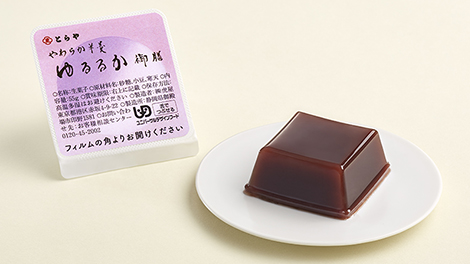
”Yururuka”
1 2
All List
- GINZA CONNECTIVE VOL.0 Ryo Sayegusa×Chisako Takashima
- GINZA CONNECTIVE VOL.1 Toshiyuki Kosaka×Chisako Takashima
- GINZA CONNECTIVE VOL.2 Yasuharu Mizuhara×Chisako Takashima
- GINZA CONNECTIVE VOL.3 Hitoshi Ishihara×Chisako Takashima
- GINZA CONNECTIVE VOL.4 Shinji Hara×Chisako Takashima
- GINZA CONNECTIVE VOL.5 Choichiro Motoyama×Chisako Takashima
- GINZA CONNECTIVE VOL.6 Noriko Okazoe×Chisako Takashima
- GINZA CONNECTIVE VOL.7 Choichiro Motoyama×Chisako Takashima
- GINZA CONNECTIVE VOL.8 Sayuri Yamaguchi×Chisako Takashima
- GINZA CONNECTIVE VOL.9 Yoshiki Tani×Chisako Takashima
- GINZA CONNECTIVE VOL.10 Yoshifumi Itoh×Chisako Takashima
- GINZA CONNECTIVE VOL.11 Kunihiko Miwa×Chisako Takashima
- GINZA CONNECTIVE VOL.12 Shin Watanabe×Chisako Takashima
- GINZA CONNECTIVE VOL.13 Akihiko Tsuda×Chisako Takashima
- GINZA CONNECTIVE VOL.14 Rie Horikawa×Chisako Takashima
- GINZA CONNECTIVE VOL.15 Jun Takahashi×Chisako Takashima
- GINZA CONNECTIVE VOL.16 Yusuke Harada×Chisako Takashima
- GINZA CONNECTIVE VOL.17 Lintaro Mizuhara×Chisako Takashima
- GINZA CONNECTIVE VOL.18 Keisuke Anzai×Chisako Takashima
- GINZA CONNECTIVE VOL.19 Hozu Yamamoto×Chisako Takashima
- GINZA CONNECTIVE VOL.20 Koji Shibata×Chisako Takashima
- GINZA CONNECTIVE VOL.21 Kayo Hosono×Chisako Takashima
- GINZA CONNECTIVE VOL.22 Mitsuru Saito×Chisako Takashima
- GINZA CONNECTIVE VOL.23 Akihisa Kawaguchi×Chisako Takashima
- GINZA CONNECTIVE VOL.24 Mamoru Sugiyama×Chisako Takashima
- GINZA CONNECTIVE VOL.25 Michiaki Kumagai×Chisako Takashima
- GINZA CONNECTIVE VOL.26 Shinichi Tanizawa×Chisako Takashima
- GINZA CONNECTIVE VOL.27 Koichi Suzuki×Chisako Takashima
- GINZA CONNECTIVE VOL.28 Munehito Matsuzaki×Chisako Takashima
- GINZA CONNECTIVE VOL.29 Hiroshi Hara × Chisako Takashima
- GINZA CONNECTIVE VOL.30 Shigeyuki Ando×Chisako Takashima
- GINZA CONNECTIVE VOL.31 Yukichi Ishikura × Chisako Takashima
- GINZA CONNECTIVE VOL.32 Seiko Yamada × Chisako Takashima
- GINZA CONNECTIVE VOL.33 Mami Nagai × Chisako Takashima
- GINZA CONNECTIVE VOL.34 Ryuta Takahashi × Chisako Takashima
- GINZA CONNECTIVE VOL.35 Kazumasa Osumi×Chisako Takashima
- GINZA CONNECTIVE VOL.36 Masahiro Kameoka×Chisako Takashima
- GINZA CONNECTIVE VOL.37 Shoichiro Watanabe×Chisako Takashima
- GINZA CONNECTIVE VOL.38 Keiji Niimoto×Chisako Takashima
- GINZA CONNECTIVE VOL.39 Chieko Nakamura ×Chisako Takashima
- GINZA CONNECTIVE VOL.40 Atsushi Yamane×Chisako Takashima
- GINZA CONNECTIVE VOL.41 Masaya Shibuya×Chisako Takashima
- GINZA CONNECTIVE VOL.42 Makoto Suzuki×Chisako Takashima
- GINZA CONNECTIVE VOL.43 Masaya Konaka×Chisako Takashima
- GINZA CONNECTIVE VOL.44 Masakazu Tanaka×Chisako Takashima
- GINZA CONNECTIVE VOL.45 Koko Kameoka × Chisako Takashima
- GINZA CONNECTIVE VOL.46 Jin Hirayama×Chisako Takashima
- GINZA CONNECTIVE VOL.47 Takashi Hoshihara×Chisako Takashima
- GINZA CONNECTIVE VOL.48 Mikiko Kimura × Chisako Takashima
- GINZA CONNECTIVE VOL.49 Keisuke Okamoto×Chisako Takashima
- GINZA CONNECTIVE VOL.50 Akira Ito × Chisako Takashima
- GINZA CONNECTIVE VOL.51 Tatsuhiko Adachi × Chisako Takashima
- GINZA CONNECTIVE VOL.52 Masahiko Yamano×Chisako Takashima
- GINZA CONNECTIVE VOL.53 Kiyoshi Kanazashi×Chisako Takashima
- GINZA CONNECTIVE VOL.54 Noriyuki Tsuji×Chisako Takashima
- GINZA CONNECTIVE VOL.55 Shoichi Kobayashi×Chisako Takashima
- GINZA CONNECTIVE VOL.56 Isao Nanjo×Chisako Takashima
- GINZA CONNECTIVE VOL.57 Shinobu Mitsuoka×Chisako Takashima
- GINZA CONNECTIVE VOL.58 Motoyoshi Yasuda×Chisako Takashima
- GINZA CONNECTIVE VOL.59 Toru Fujiki×Chisako Takashima
- GINZA CONNECTIVE VOL.60 Yuji Ida×Chisako Takashima
- GINZA CONNECTIVE VOL.61 Hitoshi Miki×Chisako Takashima
- GINZA CONNECTIVE VOL.62 Takehiko Furuya× Chisako Takashima
- GINZA CONNECTIVE VOL.63 Naoki Yoshizawa×Yusuke Yoshizawa×Chisako Takashima
- GINZA CONNECTIVE VOL.64 Kazuhito Kawase × Chisako Takashima
- GINZA CONNECTIVE VOL.65 Toshiji Yuki× Chisako Takashima
- GINZA CONNECTIVE VOL.66 Hikoyuki Yamaguchi×Chisako Takashima
- GINZA CONNECTIVE VOL.67 Daisuke Nagano×Chisako Takashima
- GINZA CONNECTIVE VOL.68 Shuichi Motohashi× Chisako Takashima
- GINZA CONNECTIVE VOL.69 Shinpei Tonaka×Chisako Takashima
- GINZA CONNECTIVE VOL.70 Shinya Kanematsu × Sachiko Takashima
- GINZA CONNECTIVE VOL.71 Masataka Yano×Chisako Takashima
- GINZA CONNECTIVE VOL.72 Mitsuhiro Kurokawa× Chisako Takashima
- GINZA CONNECTIVE VOL.73 Ryo Saegusa×Chisako Takashima








